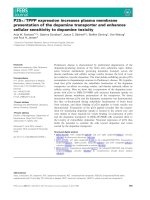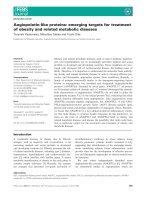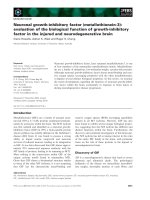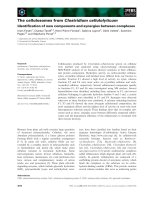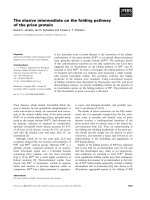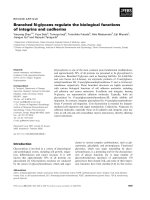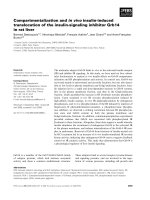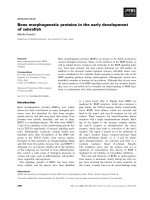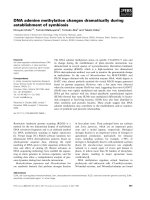Báo cáo khoa học: Misfolded endoplasmic reticulum retained subunits cause degradation of wild-type subunits of arylsulfatase A heteromers pot
Bạn đang xem bản rút gọn của tài liệu. Xem và tải ngay bản đầy đủ của tài liệu tại đây (570.83 KB, 11 trang )
Misfolded endoplasmic reticulum retained subunits cause
degradation of wild-type subunits of arylsulfatase A
heteromers
Peter Poeppel
1,
*, Mekky Mohamed Abouzied
1,2
, Christof Vo
¨
lker
1
and Volkmar Gieselmann
1
1 Institut fu
¨
r Biochemie und Molekularbiologie, Rheinische-Friedrich-Wilhelms Universita
¨
t Bonn, Germany
2 Faculty of Pharmacy, University of El-Minia, Egypt
Introduction
Many proteins form homooligomers. According to
crystallization and in vitro gel filtration data, the lyso-
somal enzyme arylsulfatase A (ASA; UniProt accession
number P15289) forms dimers at neutral pH and octa-
mers at acidic pH [1,2]. ASA is a 62 kDa soluble
protein with three N-linked oligosaccharide side chains
[3]. Within the Golgi apparatus, mannose residues of
at least two of these side chains are phosphorylated.
The resulting mannose 6-phosphate residues are impor-
tant for mannose 6-phosphate receptor-mediated lyso-
somal delivery of the enzyme. A polymorphism that is
frequent in the normal population (allele frequency of
approximately 15%) causes substitution of asparagine
350 carrying the third N-linked oligosaccharide of
the enzyme by serine. This substitution abolishes the
N-glycosylation site. Therefore, this allele codes for a
slightly smaller ASA with only two oligosaccharide
side chains [4]. This ASA has been termed pseudodefi-
ciency ASA (pdASA). Despite the loss of one N-linked
oligosaccharide side chain, the biochemical properties
of the pdASA polypeptide are largely identical to those
of the wild-type ASA (wtASA) [4,5].
Keywords
arylsulfatase A; ERAD; MLD; protein
oligomerization; protein quality control
Correspondence
V. Gieselmann, Institut fu
¨
r Biochemie und
Molekularbiologie, Rheinische-Friedrich-
Wilhelms Universita
¨
t Bonn, Nussallee 11,
53115 Bonn, Germany
Fax: +49 228 732416
Tel: +49 228 732411
E-mail:
*Present address
Institut fu
¨
r Biochemie, Universita
¨
tzuKo
¨
ln,
Germany
(Received 10 February 2010, revised 6 May
2010, accepted 18 June 2010)
doi:10.1111/j.1742-4658.2010.07745.x
Arylsulfatase A is an oligomeric lysosomal enzyme. In the present study,
we use this enzyme as a model protein to examine how heteromerization of
wild-type and misfolded endoplasmic reticulum-degraded arylsulfatase A
polypeptides affects the quality control of wild-type arylsulfatase A subun-
its. Using a conformation sensitive monoclonal antibody, we show that,
within heteromers of misfolded and wild-type arylsulfatase A, the wild-type
subunits are not fully folded. The results obtained show that arylsulfatase
A polypeptide complexes, rather than the monomers, are subject to endo-
plasmic reticulum quality control and that, within a heteromer, the mis-
folded subunit exerts a dominant negative effect on the wild-type subunit.
Although it has been shown that mature lysosomal arylsulfatase A forms
dimers at neutral pH, the results obtained in the present study demonstrate
that, in the early biosynthetic pathway, arylsulfatase A forms oligomers
with more than two subunits.
Abbreviations
ASA, arylsulfatase A; ER, endoplasmic reticulum; ERAD, ER associated degradation; HA, hemagglutinin tag; MLD, metachromatic
leukodystrophy; moab, monoclonal antibody; pdASA, pseudodeficiency arylsulfatase A; UGGT, UDP-glucose:glycoprotein glucosyltransferase;
wtASA, wild-type arylsulfatase A.
3404 FEBS Journal 277 (2010) 3404–3414 ª 2010 The Authors Journal compilation ª 2010 FEBS
Deficiency of ASA causes metachromatic leukodys-
trophy a lysosomal storage disorder, in which the degra-
dation of the sphingolipid 3-O sulfogalactosylceramide
is interrupted [6]. This leads to progressive demyelina-
tion and finally lethal neurologic symptoms. ASA
deficiency is frequently caused by missense mutations,
which cause misfolding and endoplasmic reticulum-
associated degradation (ERAD) of the respective ASAs
[7]. Because the pd allele is so frequent, a number of
mutations causing metachromatic leukodystrophy
(MLD) were identified, which occur on the background
of this allele. One of these missense mutations causes a
P377L substitution, leading to ERAD of the respective
ASA [8].
ERAD occurs when a protein does not pass the
ER quality control [9]. Various degradation pathways
exist in the ER. The best characterized of these path-
ways is proteasomal degradation of glycoproteins,
which involves the modification of their N-linked
oligosaccharide side chains [10]. These Glc
3
Man
9
Glc-
NAc
2
oligosaccharide side chains are processed to a
Glc
1
Man
9
GlcNAc
2
structure by ER glucosidases I
and II. This oligosaccharide side chain allows binding
to calnexin or calreticulin ER resident chaperones.
Deglucosylation of the Glc
1
Man
9
GlcNAc
2
structure
by ER glucosidase II releases glycoproteins from
calnexin ⁄ calreticulin [10]. UDP-glucose:glycoprotein
glucosyltransferase (UGGT) functions as a folding
sensor and reglucosylates the Man
9
GlcNAc
2
oligosac-
charides in case the released newly-synthesized
protein is not properly folded. This leads to
reassociation with calnexin ⁄ calreticulin and a new
cycle to achieve correct folding. If the protein does
not succeed in achieving the correct conformation
after repetitive deglucosylation ⁄ reglucosylation cycles,
it will be targeted for proteasomal degradation
[11,12].
It is largely unclear how UGGT recognizes specifi-
cally misfolded proteins. In vitro experiments using a
heterodimer of normal and misfolded RNAse B [11]
demonstrated that the enzyme recognizes and reglu-
cosylates selectively the misfolded subunit of the hete-
rodimer. Although oligomerization of proteins is a
frequent phenomenon, little is known with respect to
how ER quality control deals with heterooligomers of
wild-type and misfolded proteins. The variety of
defective ASAs, which are subject to ERAD [7], and
the availability of structure-sensitive monoclonal anti-
bodies identify ASA as a model protein well suited
for an investigation of the consequences of hetero-
merization of wild-type and defective proteins in more
detail.
Results
wtASA activity is diminished upon coexpression
with misfolded ASA polypeptides
In a number of experiments in which we expressed
misfolded, enzymatically inactive ASA to investigate
the biochemical consequences of missense mutations,
we noted that this reduced the endogenous ASA activ-
ity of the transfected cells. To examine this phenome-
non in more detail, we coexpressed active wild-type
and defective enzymes and measured ASA activity in
cell lysates (Fig. 1). Two aspects must be considered in
the set up of this experiment:
The first is the fraction of cells coexpressing wild-type
and defective ASA after transient transfection. To
determine the percentage of cells coexpressing both
types of enzyme, we transiently transfected BHK cells
with various amounts of plasmid expressing either green
fluorescent protein or DsRed fluorescent proteins. After
transfection, cells expressing both proteins were
counted using an immunofluorescence microscope.
Independent of the amount of DNA transfected, 70–73%
of cells expressed both proteins (data not shown).
The second fact for consideration is that sulfatases
bear a unique modification of a cysteine residue in the
active center [13]. Cotranslationally, this residue is con-
verted to formylglycine, which is essential for enzyme
activity [13]. Overexpression of sulfatases can saturate
the formylglycine-generating enzyme, so that a fraction
of the newly-synthesized sulfatases remains inactive.
Therefore, the easiest explanation for a reduction of
wtASA activity upon coexpression of a defective enzyme
is that the latter competitively displaces the wild-type
enzyme from the formylglycine-generating enzyme
[14,15]. To exclude this effect, we transiently transfected
increasing amounts of a plasmid expressing wtASA and
measured enzyme activity in cells. Figure 1A shows that
the correlation between the transfected amount of
wtASA expressing plasmid and ASA activity is approxi-
mately linear in the range 0–10 ng of plasmid. Transfec-
tion of more than 10 ng of plasmid does not lead to a
substantial further increase of ASA activity. By
contrast, when the same cells were investigated by
immunoprecipitation, the amount of ASA cross-react-
ing material correlated with the amount of transfected
plasmid up to 250 ng (data not shown). Thus, at higher
plasmid concentrations, most of the synthesized ASA is
inactive, most likely as a result of incomplete formylgly-
cine residue formation. In the range 0–10 ng of plasmid,
however, the amount of ASA activity increases propor-
tionally, showing that it is not limited by the activity of
P. Poeppel et al. ER quality control of protein heteromers
FEBS Journal 277 (2010) 3404–3414 ª 2010 The Authors Journal compilation ª 2010 FEBS 3405
the formylglycine-generating enzyme. We choose this
linear range and cotransfected 4.2 ng of plasmid
expressing wtASA cDNA with 4.2 ng of plasmid
expressing ASA cDNAs coding for various amino acid
substituted misfolded ASAs, which have been shown to
be enzymatically inactive and degraded by ERAD [7].
Coexpression of seven different defective, enzymatically
inactive enzymes in BHK cells caused a reduction of
activity to approximately 50% of controls (Fig. 1B).
The experiments were repeated in HEK293 cells, with
identical results being obtained (data not shown).
Defective ASA causes partial retention of wtASA
To verify the results shown in Fig. 1 by a different
experimental approach, we performed pulse chase
experiments in cells coexpressing wtASA and the
defective P377L-pdASA. We chose the P377L-pdASA
because this is a missense mutation occurring on the
background of the ASA pseudodeficiency allele. As
explained in the Introduction, pdASA is a naturally
occurring variant lacking one of the three ASA oligo-
saccharide side chains. The properties of pdASA, how-
ever, are largely identical to wtASA [8]. Because of the
loss of one N-linked oligosaccharide side chain,
pdASA and P377L-pdASA have a lower apparent
molecular weight by SDS ⁄ PAGE and can be easily dif-
ferentiated from wtASA (Fig. 2A, bottom). WtASA
and P377L-pdASA were expressed separately or
together in BHK cells (Fig. 2). Sixteen hours after
transfection, cells were treated with NH
4
Cl. This drug
interferes with the post Golgi sorting of lysosomal
enzymes and causes the secretion of newly-synthesized
enzymes into the medium of cultured cells. When cells
were transfected with the wtASA cDNA, they were
pulse labeled for 2 h and chased in the presence of
NH
4
Cl. To quantify wtASA present in the medium at
different chase times, we took the amount of wtASA
present in the media and cells as 100% for each time
point separately and plotted the percentage of ASA
found in media against the chase time (Fig. 2A, top).
After 20 h of chase, the majority of wtASA is secreted.
By contrast, the defective P377L-pdASA remains in the
cells (Fig. 2A, middle), which is expected as a result of
the retention of the defective enzyme in the ER [8]. In
addition, the continuous reduction of the amount of
defective enzyme during the chase period demonstrates
its degradation. When wtASA and P377L-pdASA were
coexpressed, only the wild-type enzyme appeared in the
medium, but not P377L-pdASA (Fig. 2A, bottom).
Quantification of the percentage of wtASA in the med-
ium of NH
4
Cl-treated cells expressing either the wtASA
alone or together with the P377L-pdASA revealed that
the coexpression of the P377L-pdASA decreases the
percentage of wtASA polypeptides in the medium to
approximately half of the percentage found in cells
expressing wtASA only (Fig. 2B). This indicates that
the defective P377L-pdASA is able to cause retention
of a fraction of wtASA in the cells.
The quantification of total precipitated ASA (i.e. sig-
nals from cells plus medium for each chase time)
A
B
Fig. 1. ASA activity after coexpression of wild-type and various
defective ASAs. (A) Increasing amounts (0.5–40 ng) of a plasmid
encoding wtASA were transiently transfected into BHK cells and
enzyme activity was measured 48 h after transfection. In the range
0.5–10 ng of plasmid, ASA activity increases in an almost propor-
tional manner. (B) Some 4.2 ng of plasmid expressing wtASA was
cotransfected with 4.2 ng of plasmids expressing various inactive,
misfolded ASAs (P377L-pdASA, D335V-ASA, T275M-ASA, P136L-
ASA, G86D-ASA, T201C-ASA and D255H-ASA). In the control,
these plasmids were replaced by the empty vector (pBEH). The
activity value obtained at 40 ng was taken as 100%. In all cases of
coexpression of defective ASA, the wtASA activity was lowered
below the level of expression of wild-type enzyme only. ASA activ-
ity was determined as mUÆmg
)1
protein. When expressed alone,
none of the defective ASA polypeptides displays enzymatic activity
(data not shown).
ER quality control of protein heteromers P. Poeppel et al.
3406 FEBS Journal 277 (2010) 3404–3414 ª 2010 The Authors Journal compilation ª 2010 FEBS
allows an investigation of whether coexpression of
P377L-pdASA with wtASA reduces the stability of the
latter. Figure 2C shows that wtASA, after an initial
slight decrease, is quite stable, with 80% of the enzyme
still present after 20 h. By contrast, only 20% of the
P377L-pdASA is left after 20 h. Upon coexpression of
wild-type and defective enzyme, the amount of wtASA
after 20 h is reduced to less than 50%. Obviously, the
defective P377L-pdASA enzyme leads to a more rapid
degradation of a fraction of the wild-type enzyme. By
contrast, coexpression of the defective enzyme with
wild-type enzyme does not enhance the half-life of the
P377L-pdASA. Thus, the defective enzyme has a domi-
nant negative effect on wtASA.
Wild-type and misfolded ASA polypeptides form
heteromers
The experiments presented in Figs 1 and 2 suggest an
interaction of misfolded ASA and wtASA. Because gel
filtration and crystallization studies demonstrate that
ASA forms oligomers [1,2], heteromerization of wild-
type and defective ASA subunits may offer an explana-
tion for the dominant negative effect observed. To
detect heteromerization of ASA in metabolic label-
ing ⁄ pulse experiments, wtASA was tagged with a nine
amino acid hemagglutinin (HA) peptide sequence at
the C-terminus to allow precipitation with monoclonal
antibody specific for HA (HA moab).
Figure 3A shows that the HA moab immunoprecipi-
tates HA tagged wtASA (wtASA-HA), but not untag-
ged pdASA or P377L-pdASA. Upon cotransfection,
however, the pdASA P377L-pdASA coimmunoprecipi-
tates with wtASA-HA, showing that this experimental
set up allows the examination of ASA heteromeriza-
tion. In addition to wtASA, various defective ASAs
were fused to the HA peptide sequence. This yielded
plasmids designated D335V-ASA-HA, T274M-ASA-
HA, P136L-ASA-HA, G86D-ASA-HA and D255H-
ASA-HA. All of the respective missense mutations
A
B
C
Fig. 2. Secretion and stability of wtASA is decreased by the coex-
pression of defective P377L-pdASA. (A) BHK cells were transfected
with plasmids conferring expression of wtASA or P377L-pdASA.
Cells expressed these enzymes alone (upper two panels) or in
combination (lower panel). Cells were labeled with 370 kBq of
[
35
S]methionine for 2 h and chased for the times indicated in the
presence of 10 m
M NH
4
Cl. ASA was immunoprecipitated from cell
lysat (C) and media (M) and subjected to SDS ⁄ PAGE. When cells
were harvested immediately after the pulse period (left lane), ASA
was only immunoprecipitated from the cells and not from the
media. With longer chase periods, increasing amounts of wtASA
appear in the media. (B)
35
S-labeled wtASA polypeptides of two
parallel experiments shown in (A) were quantified in the cells and
the media. The graph shows the percentage of wtASA present in
the medium (for calculations, see text). Filled circles, cells only
expressing wtASA; open circles, coexpression of defective P377L-
pdASA. The graph demonstrates that the coexpression of defective
ASA reduces the secretion of wtASA. Values represent the mean,
minima and maxima of two parallel experiments. Labeled polypep-
tides were quantified using a Fuji bioimager. (C) Graph showing the
total amount of ASA polypeptides present in the cells and media at
different chase times. The amount of ASA polypeptides present
after 2 h of pulse was taken as 100%. Whereas wtASA (filled cir-
cles) is stable over a time period of 20 h, P377L-pdASA (open
squares) is rapidly degraded. The half-life of wtASA is reduced
upon coexpression of defective P377L-pdASA (open circles). The
half-life of P377L-pdASA is unchanged upon coexpression of
wtASA (closed squares). Values are the mean, minima and maxima
of two parallel experiments. Labeled polypeptides were quantified
by Fuji bioimager.
P. Poeppel et al. ER quality control of protein heteromers
FEBS Journal 277 (2010) 3404–3414 ª 2010 The Authors Journal compilation ª 2010 FEBS 3407
were described in MLD patients, shown to be retained
in the ER [16–18] and were degraded by the protea-
some [7]. These defective HA tagged ASAs were coex-
pressed with pdASA in BHK cells (Fig. 3B). Cells
were metabolically labeled with [
35
S]methionine for
30 min and HA tagged misfolded ASA polypeptides
were immunoprecipitated with t he HA moab. Resolution
of the immunoprecipitates by SDS ⁄ PAGE revealed
coimmunoprecipitation of untagged nondefective pdASA
in all HA immunoprecipitates of HA tagged defective
ASAs. Thus, pdASA forms heteromers with all of the
misfolded ASAs examined.
To exclude the possibility that heteromer formation
is not an in vivo phenomenon but occurs after cell lysis
during immunoprecipitation, we labeled cells expressing
either wtASA-HA or pdASA only. After harvesting,
we mixed the cell lysates and performed immuno-
precipiation with HA moab. Under these conditions,
wtASA-HA did not coimmunoprecipitate pdASA,
demonstrating that heteromer formation does not
occur during immunoprecipitation but in the cells
(data not shown).
Stoichiometry of ASA oligomers
In the case where ASA forms dimers in the early stages
of biosynthesis, coexpression of equal amounts of
wtASA-HA and pdASA will yield one-third wtASA-HA
homodimers, one-third wtASA-HA⁄ pd ASA heterodi-
mers and one-third pdASA homodimers. This predicts
that coimmunoprecipitation of the untagged pdASA
by the wtASA-HA should yield intensity ratios of the
respective bands on SDS ⁄ PAGE of approximately
Transfection
Transfection
Untransfected
anti-hASA
anti-HA
anti-HA
Untagged
A
B
Fig. 3. Detection of ASA heteromers. A nine amino acid HA tag
was added to the C-terminus of wtASA (wtASA-HA) or ASAs carry-
ing various amino acid substitutions (D335V-ASA-HA, T274M-ASA-
HA, P136L-ASA-HA, G86D-ASA-HA and D255H-ASA-HA). (A) BHK
cells were transiently transfected with the indicated expression
vectors. PdASA and P377L-pdASA only have two oligosaccharide
side chains, resulting in a lower molecular weight compared to
wtASA-HA. Cells were labeled with 370 kBq of [
35
S]methionine for
2 h and subsequently harvested. Cell lysates were divided into two
aliquots and ASA polypeptides were immunoprecipitated with poly-
clonal antiserum specific for ASA (upper panel) or HA moab (lower
panel). Immunoprecipitates were resolved on SDS ⁄ PAGE and
labeled polypeptides were visualized using a Fuji bioimager. The
polyclonal ASA antiserum precipitates all polypeptides, whereas the
HA moab precipitates only the HA tagged ASA polypeptides. In
cotransfected cells (lanes 4 and 5), untagged pdASA and P377L-
pdASA are coimmunoprecipitated with the HA tagged wtASA-HA
(lower panel). (B) Different HA tagged defective ASA polypeptides,
as indicated in the top line, were transiently expressed with
pdASA, as indicated in the line below. After transfection of BHK
cells with equal amounts of vectors expressing the HA-tagged and
untagged pdASAs, cells were labeled with 3.7 MBq [
35
S]methio-
nine for 30 min. Subsequently, the cells were lysed and HA tagged
ASAs were immunoprecipitated with an HA moab from cell
lysates. Immunoprecipitates were resolved on SDS ⁄ PAGE and
labeled polypeptides were visualized using a Fuji bioimager. pdASA
coimmunoprecipitated with the various HA tagged defective ASA
polypeptides.
ER quality control of protein heteromers P. Poeppel et al.
3408 FEBS Journal 277 (2010) 3404–3414 ª 2010 The Authors Journal compilation ª 2010 FEBS
one-third (pdASA) and two-thirds (wtASA-HA),
respectively.
Whereas this is the case as shown in Fig. 3B, in
Fig. 3A, the stoichiometry is not what was expected. If
ASA was not present as a dimer but rather as an
oligomer in the early biosynthetic pathways, differ-
ences in the transfection efficiencies of the two plas-
mids encoding wtASA-HA and P377L-pdASA used in
Fig. 3 could account for the variation in ratio of the
two associated ASA polypeptides. For that reason, we
decided to examine the stoichiometry of the ASA het-
eromers in more detail by varying the ratio of the
amount of plasmids in a cotransfection experiment.
We transfected BHK cells with varying amounts of
plasmid expressing wtASA-HA and pdASA or P377L-
pdASA, respectively. Ratio of plasmids varied from
20% : 80% to 80% : 20%, respectively. After meta-
bolic labeling, the cell lysates were split into two aliqu-
ots. One aliquot was immunoprecipitated with a
polyclonal ASA antiserum precipitating all expressed
ASAs to control whether the ratios of wtASA and
pdASA or P377L-pdASA polypeptides really reflect
the ratios of the respective plasmids used for transfec-
tion. Figure 4 shows that, except for minor deviations,
this is the case. The second aliquot was immunoprecip-
itated with the HA moab to determine the amount of
the coimmunoprecipitated non-HA tagged pdASA
(Fig. 4B). Quantification of the immunoprecipitated
wtASA-HA and coimmunoprecipitated pdASA or
P377L-pdASA, respectively, revealed that one wtASA-
HA coimmunoprecipitates at least five non-HA tagged
pdASA polypeptides. This suggests that newly-synthe-
sized ASA is present at least as a hexamer.
Folding status of wtASA heteromerized with
mutant ASA
We have recently shown that wtASA folds in a sequen-
tial way, which can be followed by immunoprecipitation
with various structure-sensitive monoclonal antibodies
[7]. The hASA specific moab A2 [19] detects an epitope
of wtASA that is already formed within the first few
minutes after biosynthesis [7]. The T274M substituted
ASA, however, is severely misfolded, so that it does not
express this epitope and cannot be immunoprecipitated
by moab A2 [7]. This prompted us to investigate
whether the T274M-ASA affects folding of the wtASA
occurring in the same heteromer. Cells were transfected
with wtASA-HA, wtASA-Myc and T274M-ASA-HA,
respectively, or cells were cotransfected with different
amounts of wtASA-Myc and T274M-ASA-HA. Cell
lysates were divided into three aliquots and the ASAs
were immunoprecipitated either with polyclonal ASA
antiserum or Myc epitope specific moab or with the
hASA moab A2. The polyclonal antiserum is able to
immunoprecipitate ASA even under denaturing
conditions. Immunoprecipitates were subjected to
SDS ⁄ PAGE followed by western blotting with the HA
moab.
When wtASA-HA was expressed and immunopre-
cipitated with either polyclonal antiserum or the ASA
moab A2, the HA moab detected wtASA-HA in the
western blot of the immunoprecipitate. This confirms
that wtASA-HA is correctly folded and can therefore
be immunoprecipitated with moab A2 (Fig. 5, lane 1).
When T274M-ASA-HA was examined in the same
way, no ASA polypeptides were detected with the HA
moab after immunoprecipitation with the moab A2,
confirming that incorrectly folded T274M-ASA-HA
cannot be immunoprecipitated by the structure-sensi-
tive ASA moab A2 (Fig. 5, lane 3).
When wtASA-Myc was coexpressed with the T274M-
ASA-HA and immunoprecipitated with the moab A2,
again, no HA containing enzyme could be detected
in the immunoprecipitate (Fig. 5, lane 4). This shows
A
B
Precipition anti-hASA
Precipition anti-hHA
Fig. 4. Stoichiometry of ASA oligomerization. To determine the
stoichiometry of ASA in the oligomer, BHK cells were cotransfect-
ed with plamids expressing wtASA-HA and P377L-pdASA or
pdASA, respectively. The ratio of wtASA expressing plasmids to
pdASA or P377L-pdASA expressing plasmids, respectively, varied,
as indicated at the top. Cells were labeled with 4.1 MBq of [
35
S]-
methionine for 30 min. After harvesting, cell lysates were split into
two aliquots. One aliquot was precipitated with polyclonal ASA anti-
serum (A) and the other aliquot with the HA moab (B). Quantifica-
tion of
35
S-labeled ASA polypeptides using a Fuji bioimager shows
that one wtASA-HA can coimmunoprecipitate at least five untagged
pdASA polypeptides.
P. Poeppel et al. ER quality control of protein heteromers
FEBS Journal 277 (2010) 3404–3414 ª 2010 The Authors Journal compilation ª 2010 FEBS 3409
that the wild-type enzyme associated with the misfolded
T274M-ASA defective enzyme does not express the
A2 epitope and therefore is not completely folded.
Otherwise, T274M-ASA-HA should be detectable in
the immunoprecipitate. As a control demonstrating
wtASA-Myc and T274M-ASA-HA heteromerization,
lysates from coexpressing cells were immunoprecipitat-
ed with the Myc moab. Western blot analysis of these
immunoprecipitates shows that the T274M-ASA-HA
subunits are detectable by the HA moab after cotrans-
fection with wtASA-Myc (Fig. 5, middle). This reveals
that the inability to coimmunoprecipitate the T274M-
ASA-HA with the structure-sensitive moab A2 is not
the result of a lack of heteromerization of T274M-
ASA-HA and wtASA-Myc.
These results suggest that, within a heteromer, the
T274M substituted ASA prevents proper folding of
the wtASA. Improper conformation of the wtASA in
the heteromer may be the result of the insufficient time
available for folding because degradation as a result of
association with the defective enzyme may occur too
rapidly. Kifunensine is an inhibitor of ER a1,2-man-
nosidase I. Inhibition of this enzyme blocks the path-
way diverting a misfolded enzyme to the proteasome,
allowing more time for proper folding [20]. Therefore,
wtASA and T274M-ASA-HA were coexpressed in the
absence or presence of kifunensine. ASA was immuno-
precipitated with the moab A2 and the immunoprecipi-
tates were probed on a western blot with the HA
moab (data not shown). However, even after stabiliza-
tion with kifunensine, T274M-ASA-HA could not be
coimmunoprecipitated with wtASA, indicating that,
under these conditions, wtASA expressing the epitope
of the moab A2 was not present in the T274M-ASA-
HA ⁄ wtASA heteromers.
Discussion
Oligomerization of proteins is a frequent phenomenon,
but the mechanism by which heterooligomers of normal
and defective proteins pass ER quality control is only
poorly understood. We used the lysosomal enzyme
ASA to examine the consequences of heteromerization
of wild-type and defective ASA in more detail.
We demonstrate that, within such a heteromer, the
misfolded ASA exerts a dominant effect on the wtASA
subunit, decreasing its stability. Although we have only
shown this in detail for the P377L-pdASA, the reduc-
tion of enzyme activity upon coexpression of various
defective ASAs (Fig. 1), as well as the capability of
heteromerization for all defective ASAs investigated in
the present study, strongly suggests that this applies to
all defective ASA polypeptides.
Crystallization [2] and gel filtration experiments [1]
suggest that ASA forms dimers at neutral pH. These
studies were performed with mature lysosomal ASA,
which has passed the biosynthetic compartments and
reached its final lysosomal destination. Our data,
Immuno-
precipitation
Transfection
Western
Polyclonal
antiserum
anti-Myc
anti-HA
anti-HA
anti-HA
Moab
A2
Fig. 5. Association of misfolded T274M-ASA-HA with wtASA-Myc
prevents folding of wtASA-Myc. BHK cells were transfected with
plasmids expressing either wtASA-HA (lane 1), wtASA-Myc (lane 2)
or T274M-ASA-HA alone (lane 3), or combinations of wtASA-Myc
and T274M-HA (lane 4), as indicated at the top. ASA was immuno-
precipitated from cell lysates with either a polyclonal ASA antise-
rum recognizing ASA polypeptides even under denaturing
conditions (upper panel), or an Myc tag specific moab (middle
panel), or the structure sensitive hASA moab A2 (lower panel)
recognizing an epitope that is formed early in biosynthesis [7].
Immunoprecipitates were subjected to western blot analysis by HA
moab. In the case of the immunoprecipitation with polyclonal anti-
serum, the HA tagged ASAs can be detected from cells expressing
wtASA-HA or T274M-ASA-HA alone and from cells coexpressing
20% wtASA-Myc and 80% T274M-ASA-HA (upper panel, lanes 1,
3 and 4). When Myc moab is used for immunoprecipitation,
T274M-ASA-HA can be detected by western blot analysis from
cells coexpressing 20% wtASA-Myc and 80% T274M-ASA-HA
(middle panel, lane 4). After immunoprecipitation with moab A2,
wtASA-HA can be immunoprecipitated from cells and detected by
western blotting (lower panel, lane 1). The defective T274M-ASA-
HA cannot be immunoprecipitated with the structure sensitive
moab A2. Also, in the case of coexpressing wtASA-Myc with
T274M-ASA-HA, the defective enzyme cannot be coimmunoprecipi-
tated with wtASA-Myc, indicating that wtASA-Myc does not
express the A2 epitope and thus is not completely folded.
ER quality control of protein heteromers P. Poeppel et al.
3410 FEBS Journal 277 (2010) 3404–3414 ª 2010 The Authors Journal compilation ª 2010 FEBS
however, clearly show that, during the early biosyn-
thetic stages in vivo, the enzyme forms at least hexa-
mers, possibly octamers, which have only been
described in vitro at acidic pH. The unexpectedly high
number of ASA monomers with an oligomer cannot
be explained by the aggregation of defective ASA poly-
peptides in the ER because the same stoichiometry is
also found with nondefective pd ASA. Currently, we
do not have an explanation for the stoichiometry of
ASA, although it is possible that as yet unknown mod-
ifications occur during the early biosynthetic stages
that affect oligomerization of the enzyme.
In vitro experiments using heterodimers of native
and misfolded RNAse B have demonstrated that, even
within a RNAse heterodimer, UGGT can distinguish
the native subunit from the misfolded subunit and
reglucosylates only the latter [11]. If this process also
occurs similarly in vivo, the wtASA is expected to
remain unglucosylated within the ASA heteromers and
only the associated defective ASA would be reglucosy-
lated. Because wtASA is also trapped in the ER, the
dominant effect of the defective enzyme may then be
explained by the assumption that a single misfolded
subunit causes degradation of the heteromer irrespec-
tive of the conformational status of the other subunits.
The results obtained for the T274M-ASA, however,
offer yet another explanation. The ASA moab A2 does
not recognize denatured ASA [19]. Recent data suggest
that the antibody binds an epitope that is formed early
in ASA biosynthesis when the enzyme is partially
folded [7]. The T274M substituted ASA does not react
with moab A2, nor with any other structure-sensitive
ASA moab, indicating that it is severely misfolded.
This allowed an investigation of the folding status of
the wtASA within a heteromer with defective T274M-
ASA. If the wtASA reaches a folding state within a
heteromer that allows the expression of the A2 epi-
tope, it should be possible to immunoprecipitate the
wtASA with the moab A2 and to detect the T274M-
ASA-HA subunit afterwards in the immunoprecipi-
tates. In our experiments, however, this was not the
case. This suggests that, within the heteromer, the
wtASA does not fully proceed through its normal fold-
ing pathway. Alternatively, the folding of ASA may be
catalyzed by different chaperones acting successively
on the enzyme. In the case where a defective subunit
cannot achieve a certain conformational state, this
may prevent the entire oligomer from interacting with
chaperones catalyzing later steps of folding. In this
case, the wtASA subunit remains incompletely folded
and may be a substrate of UGGT.
Heteromerization of defective polypeptides with
their normal counterparts has been demonstrated for
several membrane proteins that are defective in domi-
nant genetic diseases. For example, defective frizzled, a
member of the Wnt signalling receptor family, forms
oligomers in the ER and can retain wild-type frizzled
in the ER [21]. Similar findings were reported for a
kidney anion exchanger defective in renal tubular aci-
dosis [22], for aquaporins in dominant diabetes insipi-
dus [23] and for the GABA
A
receptor subunit [24].
Only for the GABA
A
receptor subunit were the conse-
quences of heterooligomerization examined in detail.
Comparable to ASA, defective GABA
A
receptor sub-
units also form oligomers with wild-type subunits,
leading to the degradation of the latter by ERAD.
MLD is an autosomal recessive disease because deg-
radation of wtASA induced by defective ASA has no
biological consequence. This is expected because indi-
viduals with only 5–10% of the average ASA activity
of the normal population are healthy [25]. Obviously,
even low ASA activity maintains a normal catabolism.
According to the results obtained in the present study,
we would predict that, in carriers of defective ASA
alleles, a fraction of wtASA will be degraded. This
fraction, however, does not suffice to lower the activity
to less than 10%, which would be necessary for the
disease. Accordingly, the present study did not aim to
reveal mechanisms causing MLD. Rather, the well
characterized dimerization ⁄ octamerization status of
ASA, the availability of various structure-sensitive
antibodies and defective enzymes, as well as the known
3D structure, all qualify this protein as an ideal tool
for investigating the basic aspects of the oligomeriza-
tion of proteins in vivo in more detail.
Materials and methods
Materials
Cell culture media and supplements were obtained from
Invitrogen GmbH (Darmstadt, Germany). DNA restriction
and modifying enzymes were purchased from Fermentas
(Sankt Leon-Rot, Germany). [
35
S]methionine (specific activ-
ity > 39 TBqÆmmol
)1
) was from Hartmann Analytik
GmbH (Karlsruhe, Germany). Isolation of plasmids was
performed using the QIA-Plasmid Midi Kit Qiagen GmbH
(Hilden, Germany) in accordance with the manufacturer’s
instructions. The preparation and characterization of the
moab A2 has been described previously [20]. Hybridoma
12JA5 expressing HA antibody and 9E10 expressing Myc
antibody, were cultured in RPMI medium containing 10%
fetal bovine serum. The HA antibody was purified from the
medium by affinity chromatography using protein A sepha-
rose; the Myc antibody was purified by protein G sepharose
from GE Healthcare GmbH (Munich, Germany).
P. Poeppel et al. ER quality control of protein heteromers
FEBS Journal 277 (2010) 3404–3414 ª 2010 The Authors Journal compilation ª 2010 FEBS 3411
Generation of HA and Myc tagged hASA
To generate HA-tagged hASA proteins, hASA cDNA was
amplified via PCR from a pBEH expression vector that
contains the hASA cDNA [26,27] using the primers:
forward: 5¢-dAAAGAATTCAAGCGTAATCTGGAACA
TCGTATGGGTAGGCATGGGGATCTGGGCAATG-3¢,
reverse: 5¢-dTTTGAATTCCATGTCCATGGGGGCACC
GCGGTC-3¢. The PCR product was cloned via EcoRI
restriction sites into the expression vector pBEH. To gener-
ate wtASA-Myc proteins, oligonucleotides containing the
sequence of the Myc tag were generated: a BamHI restric-
tion site was integrated upstream of the Myc sequence and
a HindIII restriction site was integrated downstream of the
sequence. Via these restriction sites, the Myc sequence was
cloned into the pBEH vector. hASA cDNA was amplified
via PCR from the pBEH expression vector using the prim-
ers: forward: 5¢-dAAAGGATCCGGCATGGGGATCTGG
GCAATG-3¢, reverse: 5¢-dTTTGAATTCCATGTCCATGG
GGGCACCGCGGTC-3¢. The hASA was cloned via EcoRI
and BamHI sites into the Myc containing pBEH expression
vector.
DNA transfection and ASA activity determination
Transfection of expression plasmids into BHK cells was
performed with ExGen 500 (Fermentas). Twenty four
hours prior to transfection, 8 · 10
4
per 4 · 10
5
BHK cells
were seeded onto 24-well per six-well plates, respectively.
For transfection, 22.5 lL per 121.5 lL 150 mm NaCl was
mixed with 0.5 lg per 2.7 l g of DNA, respectively; then
1.7 lL per 8.9 lL ExGen 500 was added and incubated
for 10 min after mixing. Transfection solution was added
to 225 lL per 1215 lL DMEM containing 5% fetal
bovine serum and then added to the cells. Fourteen hours
later, the DNA ⁄ transfection reagent containing medium
was removed and replaced by serum-containing medium.
To determine ASA activity, cells were harvested 48 h later.
Twenty microliters of cell lysate, containing 20–50 lgof
protein, were incubated with 200 lL of substrate solution
(10 mm para-nitrocatecholsulfate in 0.5 m sodium acetate,
pH 5.0, 10% w ⁄ v NaCl and 0.3% Triton X-100) for 30–
60 min at 37 °C. The reaction was terminated by the addi-
tion of 500 lLof1m NaOH. Absorption was measured
at 515 nm. Protein content was determined with the DC
assay protein determination kit from Bio-Rad (Hercules,
CA, USA) in accordance with the manufacturer’s instruc-
tions.
Metabolic labeling and immunoprecipitation
Protocols for metabolic labeling with [
35
S]methionine and
for subsequent immunoprecipitation of ASA have been
described in detail previously [28]. Secretion of newly-syn-
thesized enzymes was enhanced by the addition of NH
4
Cl
in a final concentration of 10 mm. The drug was also pres-
ent during labeling periods. Quantification of the precipi-
tated proteins was performed after SDS ⁄ PAGE with a Fuji
bioimager (Fuji, Tokyo, Japan). Pixels of the corresponding
polypeptide band were integrated by the software aida
(raytest GmbH, Straubenhardt, Germany). After subtrac-
tion of background values, the numbers obtained were
taken as arbitrary values for the amount of
35
S-labeled
ASA.
Immunoprecipitation and western blot
Cell lysates of hASA expressing cells were incubated with
either monoclonal hASA antibody A2 or polyclonal ASA
antiserum or the monoclonal antibody against the Myc tag.
The antigen antibody complex was precipitated by Pansor-
bin A in the case of hASA antibodies or protein G sepha-
rose in the case of aMyc moab and washed three times
with NaCl ⁄ P
i
. After SDS ⁄ PAGE, the proteins were blotted
onto a nitrocellulose membrane. hASA-HA was detected
by a biotinylated HA antibody and fluorophore-labeled
streptavidin. Detection was performed using a Li-Cor laser
scanner (Li-Cor, Lincoln, NE, USA).
Biotinylation of HA antibody
NaCl ⁄ P
i
buffered HA antibody (2 mgÆmL
)1
) was incubated
with a 20-fold molar excess of EZ-Link
Ò
Sulfo-NHS-SS-
Biotin (Pierce, Rockford, IL, USA) for 30 min. The
remaining free biotin was removed by fast desalting gelfil-
tration on a SMART FPLC (GE Healthcare Europe, Frei-
burg, Germany).
Acknowledgements
This work was supported by a grant from the Euro-
pean Leukodystrophy Foundation, the Deutsche Fors-
chungsgemeinschaft and the BMBF. The costs of
publication of this article must therefore be marked as
an ‘advertisement’ in accordance with this fact.
References
1 von Bulow R, Schmidt B, Dierks T, Schwabauer N,
Schilling K, Weber E, Uson I & von Figura K (2002)
Defective oligomerization of arylsulfatase A as a cause
of its instability in lysosomes and metachromatic leuko-
dystrophy. J Biol Chem 277, 9455–9461.
2 Lukatela G, Krauss N, Theis K, Selmer T, Gieselmann
V, von Figura K & Saenger W (1998) Crystal structure
of human arylsulfatase A: the aldehyde function and
the metal ion at the active site suggest a novel mecha-
nism for sulfate ester hydrolysis. Biochemistry 37, 3654–
3664.
ER quality control of protein heteromers P. Poeppel et al.
3412 FEBS Journal 277 (2010) 3404–3414 ª 2010 The Authors Journal compilation ª 2010 FEBS
3 Sommerlade HJ, Selmer T, Ingendoh A, Gieselmann V,
von Figura K, Neifer K & Schmidt B (1994) Glycosylation
and phosphorylation of arylsulfatase A. J Biol Chem
269, 20977–20981.
4 Gieselmann V, Polten A, Kreysing J & von Figura K
(1989) Arylsulfatase A pseudodeficiency: loss of a poly-
adenylylation signal and N-glycosylation site. Proc Natl
Acad Sci USA 86 , 9436–9440.
5 Leistner S, Young E, Meaney C & Winchester B (1995)
Pseudodeficiency of arylsulphatase A: strategy for clari-
fication of genotype in families of subjects with low
ASA activity and neurological symptoms. J Inherit
Metab Dis 18, 710–716.
6 von Figura K, Gieselmann V & Jaeken J (2001)
Metachromatic leukodystrophy. In The Metabolic and
Molecular Bases of Inherited Disease (Scriver CR,
Beaudet AL, Sly WS, Valle D, Childs B, Kinzler KW
& Vogelstein B eds), pp. 3695–3724. McGraw-Hill,
New York.
7 Poeppel P, Habetha M, Marcao A, Bussow H, Berna L
& Gieselmann V (2005) Missense mutations as a cause
of metachromatic leukodystrophy. Degradation of aryl-
sulfatase A in the endoplasmic reticulum. Febs J 272,
1179–1188.
8 Hess B, Saftig P, Hartmann D, Coenen R, Lullmann-
Rauch R, Goebel HH, Evers M, von Figura K,
D’Hooge R, Nagels G et al. (1996) Phenotype of
arylsulfatase A-deficient mice: relationship to human
metachromatic leukodystrophy. Proc Natl Acad Sci USA
93, 14821–14826.
9 Ellgaard L, Molinari M & Helenius A (1999) Setting
the standards: quality control in the secretory pathway.
Science 286, 1882–1888.
10 Helenius A & Aebi M (2004) Roles of N-linked glycans
in the endoplasmic reticulum. Annu Rev Biochem 73,
1019–1049.
11 Ritter C & Helenius A (2000) Recognition of local
glycoprotein misfolding by the ER folding sensor
UDP-glucose:glycoprotein glucosyltransferase. Nat
Struct Biol 7, 278–280.
12 Trombetta SE & Parodi AJ (1992) Purification to
apparent homogeneity and partial characterization of
rat liver UDP-glucose:glycoprotein glucosyltransferase.
J Biol Chem 267, 9236–9240.
13 Dierks T, Schmidt B & von Figura K (1997) Conver-
sion of cysteine to formylglycine: a protein modification
in the endoplasmic reticulum. Proc Natl Acad Sci USA
94, 11963–11968.
14 Dierks T, Schmidt B, Borissenko LV, Peng J, Preusser
A, Mariappan M & von Figura K (2003) Multiple sul-
fatase deficiency is caused by mutations in the gene
encoding the human C(alpha)-formylglycine generating
enzyme. Cell 113, 435–444.
15 Takakusaki Y, Hisayasu S, Hirai Y & Shimada T
(2005) Coexpression of formylglycine-generating enzyme
is essential for synthesis and secretion of functional
arylsulfatase A in a mouse model of metachromatic leu-
kodystrophy. Hum Gene Ther 16, 929–936.
16 Hess B, Kafert S, Heinisch U, Wenger DA, Zlotogora J
& Gieselmann V (1996) Characterization of two arylsul-
fatase A missense mutations D335V and T274M caus-
ing late infantile metachromatic leukodystrophy. Hum
Mutat 7, 311–317.
17 Hermann S, Schestag F, Polten A, Kafert S, Penzien
J, Zlotogora J, Baumann N & Gieselmann V (2000)
Characterization of four arylsulfatase A missense
mutations G86D, Y201C, D255H, and E312D causing
metachromatic leukodystrophy. Am J Med Genet 91,
68–73.
18 Kafert S, Heinisch U, Zlotogora J & Gieselmann V
(1995) A missense mutation P136L in the arylsulfatase
A gene causes instability and loss of activity of the
mutant enzyme. Hum Genet 95
, 201–204.
19 Schierau A, Dietz F, Lange H, Schestag F, Parastar A
& Gieselmann V (1999) Interaction of arylsulfatase A
with UDP-N-acetylglucosamine:Lysosomal enzyme-N-
acetylglucosamine-1-phosphotransferase. J Biol Chem
274, 3651–3658.
20 Tokunaga F, Brostrom C, Koide T & Arvan P (2000)
Endoplasmic reticulum (ER)-associated degradation of
misfolded N-linked glycoproteins is suppressed upon
inhibition of ER mannosidase I. J Biol Chem 275,
40757–40764.
21 Kaykas A, Yang-Snyder J, Heroux M, Shah KV,
Bouvier M & Moon RT (2004) Mutant Frizzled 4 asso-
ciated with vitreoretinopathy traps wild-type Frizzled in
the endoplasmic reticulum by oligomerization. Nat Cell
Biol 6, 52–58.
22 Quilty JA, Cordat E & Reithmeier RA (2002) Impaired
trafficking of human kidney anion exchanger (kAE1)
caused by hetero-oligomer formation with a truncated
mutant associated with distal renal tubular acidosis.
Biochem J 368, 895–903.
23 Kamsteeg EJ, Wormhoudt TA, Rijss JP, van Os CH &
Deen PM (1999) An impaired routing of wild-type aqu-
aporin-2 after tetramerization with an aquaporin-2
mutant explains dominant nephrogenic diabetes insipi-
dus. EMBO J 18 , 2394–2400.
24 Kang JQ, Shen W & Macdonald RL (2009) The GAB-
RG2 mutation, Q351X, associated with generalized epi-
lepsy with febrile seizures plus, has both loss of
function and dominant-negative suppression. J Neurosci
29, 2845–2856.
25 Penzien JM, Kappler J, Herschkowitz N, Schuknecht
B, Leinekugel P, Propping P, Tonnesen T, Lou H,
Moser H, Zierz S et al. (1993) Compound heterozygos-
ity for metachromatic leukodystrophy and arylsulfatase
A pseudodeficiency alleles is not associated with pro-
gressive neurological disease. Am J Hum Genet 52 ,
557–564.
P. Poeppel et al. ER quality control of protein heteromers
FEBS Journal 277 (2010) 3404–3414 ª 2010 The Authors Journal compilation ª 2010 FEBS 3413
26 Artelt P, Morelle C, Ausmeier M, Fitzek M & Hauser
H (1988) Vectors for efficient expression in mammalian
fibroblastoid, myeloid and lymphoid cells via transfec-
tion or infection. Gene 68, 213–219.
27 Stein C, Gieselmann V, Kreysing J, Schmidt B, Pohl-
mann R, Waheed A, Meyer HE, O’Brien JS & von Fig-
ura K (1989) Cloning and expression of human
arylsulfatase A. J Biol Chem 264, 1252–1259.
28 Gieselmann V, Schmidt B & von Figura K (1992) In vitro
mutagenesis of potential N-glycosylation sites of arylsul-
fatase A. Effects on glycosylation, phosphorylation, and
intracellular sorting. J Biol Chem 267, 13262–13266.
ER quality control of protein heteromers P. Poeppel et al.
3414 FEBS Journal 277 (2010) 3404–3414 ª 2010 The Authors Journal compilation ª 2010 FEBS
